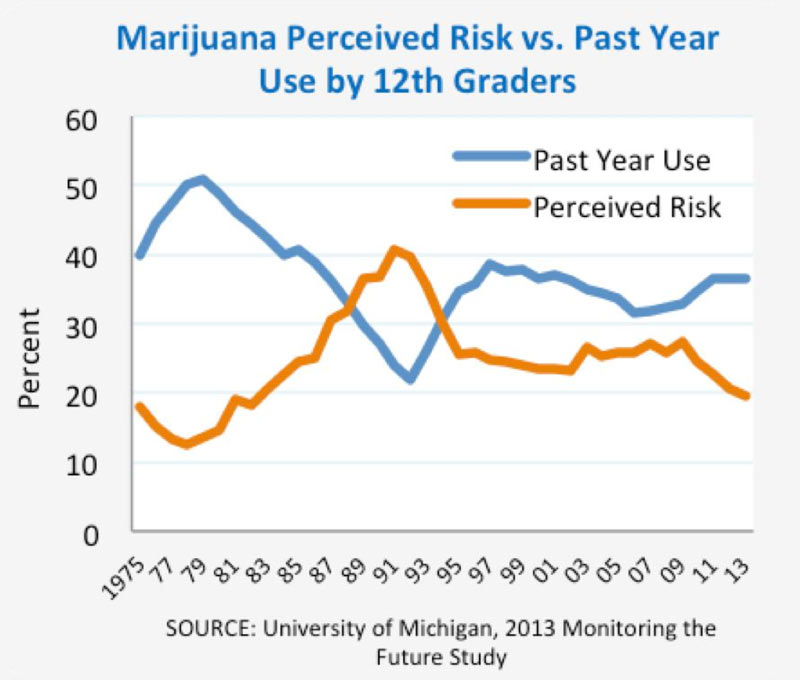Twenty-eight states and the District of Columbia have legalized “medical marijuana” and 8 states have legalized recreational cannabis use. Does this mean that marijuana is harmless? That it is safe? That it is not addictive? What does the science actually reveal?
• Cannabis is the most commonly used illicit substance in the United States and worldwide.
• Cannabis is addictive and the younger one starts using it, the greater the likelihood of addiction.
o One out of eleven (9%) adults who try cannabis become addicted.
o One out of six (17%) adolescents who try cannabis become addicted (Hall, 2009; Volkowet al., 2014).
Cannabis has changed over the years and is much more potent today than just a few decades ago, thus increasing the risk of addiction, as well as mental health problems. In 1992, the average potency of delta-9-tetrahydrocannabinol (THC) in seized cannabis was 3% but by 2019 the potency had increased to 11%–an almost fourfold increase! And this increase in potency correlates with increased number of hospital admissions for cannabis use disorders.
Cannabis contains more than 460 active chemicals and more than 100 unique cannabinoids. These are the compounds that interact with the brain’s cannabinoid receptors.
Cannabis (including “medical marijuana” in dispensaries) is not standardized in dose, potency, or chemical constituency, which means you don’t know what you’re getting from one marijuana sample to the next.
So, what does the published research demonstrate?
• Most studies (70%) done on cannabis are deemed to have “high-risk of bias” due to methodological flaws and author biases.
• Only 57% had appropriate participant blinding and only 24% with appropriate blinding of outcome assessors. (This means preventing the participants and assessors from knowing who was getting real cannabis and who was getting placebo.)
• Most research was done on oral cannabinoids, which contained only one or two of the more than 100 active compounds; only two studies involved actual cannabis (smoked in one study, vaporized in another.)
• Thus, all the hype suggesting safety of cannabis is just that, hype and not science.
Of the studies that were well done, the researchers concluded that there was moderate evidence of medical benefit from cannabis for chronic pain and muscle spasticity. There was poor-quality evidence for the treatment of nausea/vomiting due to chemotherapy, weight gain in HIV, sleep disorders, and Tourette syndrome.
This means that the medical benefits are narrow and much more evidence is needed. However, since many states have legalized medical marijuana, it has led to the perception amongst young people that marijuana is not harmful.
The graphic below demonstrates how attitudes among high school students have changed from 1975 to 2013:

Another issue that perpetuates the false idea that marijuana is harmless is that it is “natural.” But natural doesn’t always mean harmless! Consider tobacco, poison ivy, poison mushrooms or foxglove (a plant from which the cardiac medicine digoxin is derived, and small overdose of it will stop the heart). All of these are natural products but are poisonous or toxic. No, natural doesn’t always mean harmless.
Perception about marijuana is critically important and we must educate young people about the health damaging effects of it, just as we have done regarding tobacco.
Surveys show that 45% of U.S. high school seniors have used marijuana, 23% use currently, and 6% use daily (Johnston et al., 2016). The more marijuana is used the more damage it does to the brain. In a dose-dependent manner, adolescent cannabis use is associated with worse performance in school, work, thinking, increased psychiatric disorders, and worsened substance use outcomes (Pope et al., 2003; Fergusson et al., 2015, Jager& Ramsey, 2008; Meier et al., 2012; Randolph et al., 2013; Camchonget al., 2016, Fergusson et al., 2002; Patton et al., 2002; Moore et al., 2007, Patton et al., 2007.Volkowet al., 2014, 2016; Levine et al., 2017).
Cannabis use in adolescence is associated with increased incidence and worsened course of psychotic, mood, and anxiety disorders (Hayatbakhshet al., 2007; Moore et al., 2007; Gage 2016).
Several studies have documented that adolescents who smoke marijuana have a loss of IQ points, more than a standard deviation, that is never fully recovered after stopping the marijuana (Pope 2003, Gruber 2011, Meier 2012).
The bottom line is that marijuana is a neuro-active substance that has multiple damaging effects on the brain. It reduces IQ, increases mental illness and increases the risk of multiple health problems. Furthermore, there is essentially no research on the more than 400 chemical compounds contained within cannabis.
We must move away from myth to truth and educate our young people on the dangers of this substance.
Remember, humans can pass laws to make marijuana legal—but we can never pass laws to make it healthy! Mature people are those who choose to operate in harmony with design law—the laws upon which life and health are built—so even when society makes something legal, if it is unhealthy, the mature wont damage their bodies with it.

Comments
One response to “Marijuana—The Science Behind the Smoke”
People need to know the real facts. Thanks for telling the truth!